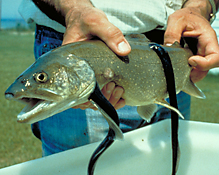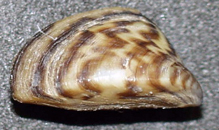Aquatic Invasives
The waters of the Grand River system and Lake Erie are now home to several invasive species, which are not native to Ontario. Some of these species eat the young of native species or outcompete them for habitat and food. In other cases, they can actually change the habitat, making it less suitable for native species. Anglers and boaters should be aware of and help prevent the spread of aquatic invasive species into new waterways.
Report invasive species
If you spot an invasive species in the wild, call the Invasive Species Hotline at 1-800-563-7711 or report it online.
Asian carp
Three species of Asian carp - silver, bighead and grass - have spread through parts of the United States and risk getting into the Great Lakes. They represent one of the greatest threats to the lakes and their tributaries, including the Grand.

They can reach 40 kilograms (100 pounds) and are voracious eaters. They easily outcompete native species for food. They are a hazard for boaters because they can jump up to three meters (10 feet) out of the water.
Some Asian carp were originally brought to North America and placed in plant-clogged waterways to clear them. Sterilized carp are still used for that purpose in some Great Lakes states. Sterilized Asian carp have been found around the mouth of the Grand River at Lake Erie . They may have come from the U.S. side of the lake.
Round goby
Round goby is present within the Grand River as far north as Belwood Lake near Fergus. The species was also found at Guelph Lake in 2019.

These small fish feed aggressively and compete with native fish for food. They also eat the eggs and young of sport fish. They may be a source of botulism that affects fish and fish-eating birds.
Round goby looks like several species of native fish so are unknowingly moved by anglers into new areas. If you catch them, destroy them. It is illegal to use them as bait. Boaters should drain their ballast before leaving water access so gobies are not transferred to another water body.
Sea lamprey
Sea lamprey was first detected within the Great Lakes in the 1930s. The species occurs in the Grand as far north as the Caledonia Dam.

Lampreys use their sucker mouth, sharp teeth and rasping tongue to attach themselves to fish and drain their blood. One lamprey can destroy 18 kilograms of fish.
Various control measures have reduced the lamprey population by 90 per cent but the remaining ones still affect native fish species.
Rusty crayfish
Rusty crayfish have been in Ontario since the 1960s and the Grand River since 1987.

Rusty crayfish is larger than native crayfish and consumes twice as much food. These crayfish will eat almost anything including fish eggs, small fish and other aquatic creatures. They compete for food with juvenile game fish and other fish species.
One way to control their spread is to never move bait buckets full of crayfish from one body of water to another.
Zebra mussels
Zebra mussels have altered the Lake Erie ecosystem. They consume algae, zooplankton and other food, upsetting the food chain, which results in reductions in perch and walleye. They also attach themselves to hard surfaces and can cover it completely. Their sharp shells foul beaches.

They are present in the Grand River between Lake Erie and Dunnville Dam, and were detected at Guelph Lake in 2018. If they were to multiply and spread, they could interfere with the operation of machinery at water plants, hydro intakes and dams. Removing them from equipment and infrastructure would cost thousands of dollars.
More information
- Ontario's Invading Species Awareness Program provides detailed information on invasive plants, animals, insects and aquatic species.
- Invasive Species Centre provides information on Canada's invasive species, including a link to the EDDMaps reporting tool.
Contact Us
Grand River Conservation Authority
400 Clyde Road, PO Box 729
Cambridge, ON
N1R 5W6
Phone: 519-621-2761
Toll Free: 1-866-900-4722
grca@grandriver.ca
